Improve Your Learning
Question 1.
A solid sphere has a radius of 2 cm and a mass of 0.05 kg. What is the relative density of the sphere? (AS 1)
Answer:
Radius of the sphere = 2 cm
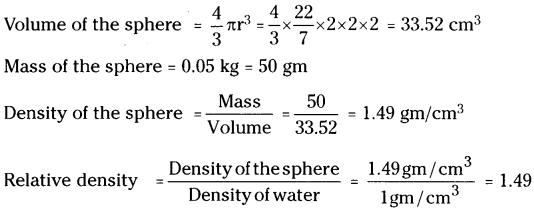
Question 2.
A small bottle weighs 20 g when empty and 22 g when filled with water. When it is filled with oil it weighs 21.76 g. What is the density of oil? (AS 1)
Answer:
Weight of water = 22 - 20 = 2 gm
Weight of oil = 21.76 - 20 = 1.76 gm

Question 3.
An ice cube floats on the surface of a glass of water (density of ice = 0.9 g/cm3). When the ice melts will the water level in the glass rise? (AS 1)
Answer:
Yes, the water level rises.
Reason :
The ice cube floats on water, because its density is less than the density of water. When ice cube melts, it becomes water, so that the water level rises.
Question 4.
The volume of 50 g of a substance is 20 cm3. If the density of water is 1 g/cm3, will the substance sink or float when placed on the surface of water? What will be the mass of water displaced by the substance? (AS 1)
Answer:
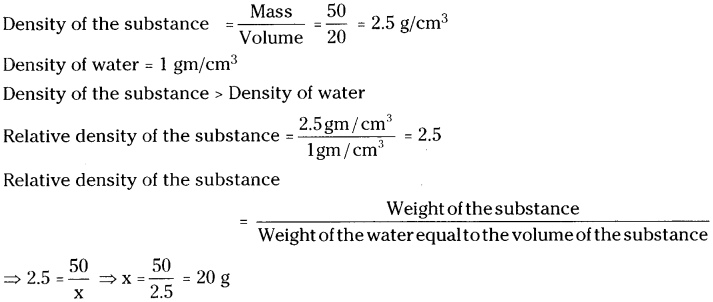
∴ Weight of the water displaced by the substance = 20 g
Question 5.
Find the pressure at a depth of 10 m in water if the atmospheric pressure is 100 kPa. [1Pa = 1 N/m2] [100kPa = 105Pa = 105N/m2 = 1 atm.] (AS 1)
Answer:
Depth ‘h’ = 10 m ; Atmospheric pressure P0= 100 kPa
Density of water p = 1 gm/cm3 = 1 kg/m3
Pressure at a depth ‘h’ is P = P0+ hρg
= 100 + 10 x 1 x 9.8
= 100 + 98
= 198 kPa
Question 6.
Why do some objects float on the water? And some sink? (AS 1)
Answer:
- Floating or sinking of objects on water depends on two factors.
a) Relative density
b) Weight of the water displace by the object
- If the relative density of an object is greater than 1, the object sinks otherwise it floats.
- Eventhough the relative density is greater than 1, if the weight of the water displaced by the object equal to the weight of the object itself, the object floats on the water.
Question 7.
Explain density and relative density and write their formulae. (AS 1)
Answer:
Density :
Density is defined as mass per unit volume.
Density =Mass/Volume
Unit of density is gm/cm3 or kg/m3.
Relative density :
Relative density of an object is the ratio of density of the object to the density of water.

Question 8.
What is the value of density of water? (AS 1)
Answer:
Value of density of water = 1 gm/cm3 (or) 1 kg/cm3.
Question 9.
Find the relative density of wood. Explain the process. (Lab Activity 1) (AS 3)
Answer:
Aim :
To find the relative density of wood.
Materials required :
Overflow vessel, 50 ml measuring cylinder, spring balance, wooden block, water.

Procedure:
- Weigh the 50 ml measuring cylinder and note its weight.
- Weigh the wooden block and note its weight.
- Pour water in the overflow vessel until it starts dripping from its beak.
- When water stops dripping from the beak, place the 50 ml measuring cylinder under it.
- Slip the wooden block gently into the overflow vessel, ensuring that the water does not splash out.
- Once the wooden block is in the overflow vessel, water flows out of the beak and collects in the 50 ml cylinder.
- Wait till the flow of water from beak, stops.
- Weigh the cylinder with the water that overflowed and record the weight.
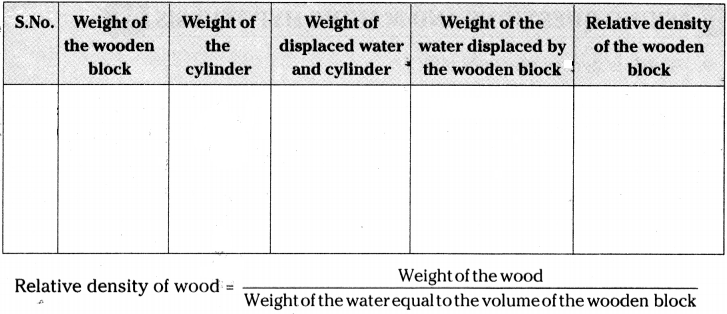
Question 10.
Which is denser, water or milk? (AS 2)
Answer:
The density of water is 1 gm/cc and that of milk is 1.02 gm/cc. Hence milk is slightly denser than water.
Question 11.
What is buoyancy? (AS 1)
Answer:
Buoyancy is the upward force that a fluid exerts on an object less denser than itself.
(or)
Buoyancy is the ability of an object to float in a liquid.
Question 12.
Classify the following things into substances having relative density > 1 and relative density < 1. Wood, iron, rubber, plastic, glass, stone, cork, air, coal, ice, wax, paper, milk, kerosene, groundnut oil, soap. (AS 1)
Answer:
| Relative density > 1 |
Relative density < 1 |
| Iron |
Wood |
| Glass |
Rubber |
| Stone |
Plastic |
| Milk |
Cork |
| Soap |
Air |
|
Coal |
|
Ice |
|
Wax |
|
Paper |
|
Kerosene |
|
Groundnut oil |
Question 13.
How can you appreciate the technology of making ships float, using the material which sink in water? (AS 6)
Answer:
- We know that a piece of iron sinks in water.
- The relative density of iron is 8.5 which is many times more than water.
- A ship that floats on water is made up of tonnes of iron. It is really wonderful.
- According to the Archimedes principle of buoyancy, any object can float when its weight is equal to the weight of water displaced by it.
- Hence ships are made with a larger surface area so that it displaces the water, whose weight is equal to the weight of loaded ship.
- It involves very sharp scientific calculations and a large engineering technology.
- Really such type of technologies are highly appreciable and the scientists who formulates all these are also really great.
Question 14.
Can you make iron float? How? (AS 3)
Answer:
Yes, we can make iron to float on water.
Procedure:
- Take a piece of iron and drop it in a vessel of water.
- We observe that the iron piece sinks in water.
- Take a thin foil of iron and fold it into four folds.
- Drop it in water. It sinks.
- Now unfold the foil and bend it in the form of a bowl. [You can use an iron tin also]
- Now drop the bowl in water.
- If floats on water.
Reason:
The weight of water displaced by iron bowl (iron tin) is less than the weight of the iron bowl (iron tin).
Question 15.
How can you find the relative density of a liquid? (Lab Activity – 2) (AS 3)
Answer:
Aim :
To find the relative density of a liquid.
Materials required :
Small bottle of 50 ml capacity (the bottle should weigh not less than 10 gm), spring balance, any liquid (milk or oil or kerosene) about 50 ml.
Procedure:
- Find the weight of empty 50 ml bottle.
- Fill the bottle with water and weigh it.
- Find the weight of 50 ml water.
- Remove water from the bottle and fill it with any liquid (say milk).
- Weigh the bottle with liquid.
- Weight of 50 ml liquid = Weight of bottle with liquid – Weight of empty bottle
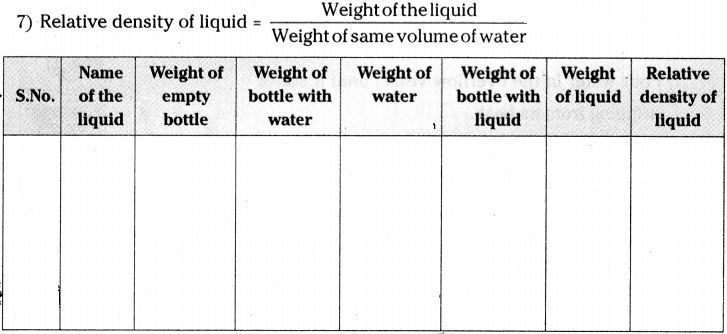
Question 16.
Find the relative density of different fruits and vegetables and make a list. (AS 3)
Answer:
- Follow the procedure in Q.No (11) of A.S - (3).
- Use different fruits and vegetables in the place of wooden block.
- Write the observed values in the following table.
| Name of the fruit or vegetable |
Relative density |
| Cabbage |
0.36 |
| Cauliflower |
0.26 |
| Bottleguard |
0.56 |
| Potato |
0.67 |
| Onion |
0.59 |
| Chilli |
0.29 |
| Bitterguard |
0.4 |
| Apple |
1.22 |
| Grape |
1.04 |
| Orange |
0.34 |
Question 17.
Make a lactometer with ball point refill. What would you do to make the refill stand vertically straight? (Activity - 2) (AS 5)
Answer:
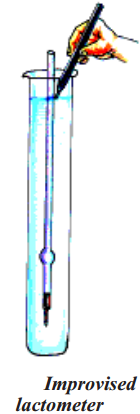
- Take an empty ball pen refill. It should have a metal point.
- Take a boiling tube and fill it with water.
- Put the refill in with metallic point inside the water.
- Use a pen to mark the point on the refill to show the part which is above the water surface.
- Pour out the water from the boiling tube and fill it with milk.
- Float the refill in the milk.
- Puf the record mark on the refill, at the point showing the part which is above the surface of the milk.
- These two marks are not at the same place. This is the improvised lactometer.
- We have to attach a small weight at the bottom of the refill to make it stand vertically straight.
Question 18.
Draw the diagram of a mercury barometer. (AS 5)
Answer:
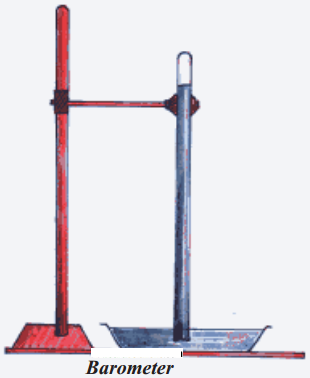
Question 19.
Write a note on Pascal’s discovery in helping to make hydraulic jacks. (AS 6)
Answer:
Pascal’s principle:
External pressure applied to an enclosed body of fluid is transmitted equally in all directions throughout the fluid volume and the walls of the containing vessel.
Use :
- This principle is used in designing and working of hydraulic jacks.
- Hydraulic jacks are useful to lift heavy objects like cars and other vehicles in automobile work shops when the vehicles are to be required or repaired.
- Here very less force is used to lift such heavy vehicles.
Appreciation :
- Hydraulic jacks are used not only in automobile work shops, but also in so many industries where heavy weights are to be lifted with a little force.
- All the comforts which we are enjoying now are the efforts of scientists who discovered the laws and principles.
- Hence we have to appreciate the efforts of Pascal for his contribution in designing these principles.
Question 20.
Write a note on Archimedes discovery of force of buoyancy. (AS 6)
Answer:
Archimedes principle:
When a body is immersed in a fluid, it experiences an upward force of buoyancy equal to the weight of fluid displaced by the immersed portion of the body.
Use :
The principle is used to determine the purity of metals.
Appreciation :
- This principle was discovered by Archimedes eventually when he was taking bath.
- With this principle he could solve the problem assigned by the king to him.
- So many problems in our life may be solved by so many scientific principles discovered by various scientists.
- You might have heard about falling of the statue of Budha in Hussain Sagar.
- That statue was lifted by using the principle of buoyancy.
- Archimedes is thought to be so important as a mathematician that scientists honoured him.
a) A large hole or crator on the moon is named after Archimedes.
b) Some mountains on the moon are called the monte – Archimedes.
- Hence the efforts of Archimedes in discovering such type of principle may be highly appreciated.
Question 21.
You found the relative densities of some solids and some liquids by doing some activities. List the solids and liquids in increasing order of relative density. (AS 4)
Answer:
| Substance |
Relative density |
| Kerosene |
0.81 |
| Rubber |
0.94 |
| Milk |
1.02 |
| Glass |
1.29 |
| Iron |
8.5 |
Question 22.
Iron sinks in water, wood floats in water. If we tie an iron piece to wood piece of the same volume, buritlle and drop it in water, would bundle sink or float? Make a guess and find out whether your guess is correct or wrong with an experiment. Give reasons. (AS 2, AS 3)
Answer:
The body sinks in water.
Reason :
The combined mass of the system increases, so the combined density also increases. Hence the body sinks in water.
Question 23.
Air brakes in automobiles work on Pascal’s principle. What about air brakes? Collect the information about the working process of air brakes. (AS 4)
Answer:
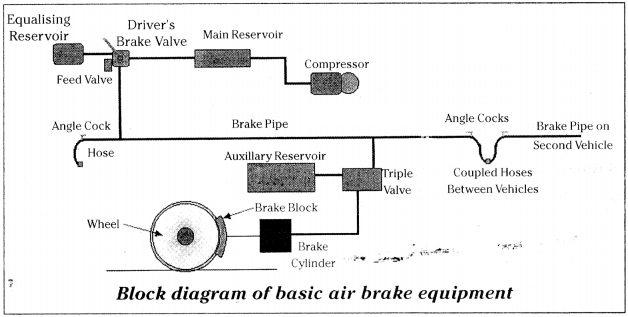
- Air brakes works on the principle of conversion of energy. Generally in trains, while it is moving -fit .produces kinetic energy. This kinetic energy has to be reduced to make the train stop. Here air is used to reduce kinetic energy by converting it into heat energy.
- The system of air brakes in trains has been shown in the figure.
- The important parts are compressor, main reservoir, driver’s brake value, brake pipe, triple value, auxiliary reservoir, brake cylinders, and brake block.
Working:
- When the driver placed the value in application position, the air pressure in the brake pipe escapes.
- The loss of pressure is detected by the slide value in the triple value.
- Now a connection between the auxiliary reservoir and the brake cylinder has been opened and the air in the auxiliary reservoir feeds through into the brake cylinder.
- The air pressure forces the piston to move against the spring pressure and causes the brakes to be applied to the wheels.
Question 24.
Where do you observe Archimedes principle in daily life? Give two examples.
Answer:
Daily life application of Archimedes principle :
- Archimedes principle of buoyancy is applied in our daily life in many ways.
- Fish, human swimmers, ice bergs and ships float follow Archimedes principle of buoyancy.
- Rise of balloon in air also follows Archimedes principle.
- While dragging water from a well, the bucket filled with water seems to be weightless till it reaches the surface of the water in the well. This is also due to buoyancy.
- Swimming of duck in water is also an example of Archimedes principle.
Question 25.
Where do you observe Pascal’s principle in daily life? Give a few examples.
(OR)
Write any one application of Pascal’s principle in daily life.
Answer:
Daily life application of Pascal’s principle :
Pascal’s principle is applied in the working of
- Hydraulic jacks
- Hydraulic lifts
- Hydraulic pumps
- Hydraulic cranes
- Siphons
- Artesian wells
- Water towers and dams